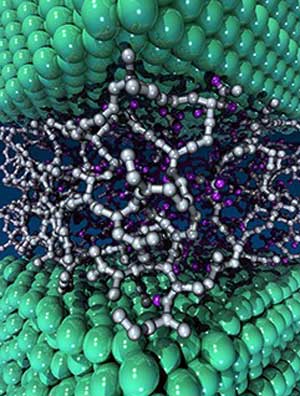| Posted: Jan 09, 2017 |
Giving friction the slip with new carbon nanofilms
(Nanowerk News) In engines, motor oil additives improve lubricity, although they can damage the environment. Argonne National Laboratory scientists discovered new coatings for engine parts with exceptional anti-wear properties (Nature, "Carbon-based tribofilms from lubricating oils").
|
|
Advanced computational simulations, performed in part at Argonne’s Center for Nanoscale Materials, traced the origin of the anti-wear properties to new catalytic phenomena possible only under the extreme conditions afforded by friction.
|
 |
| Prediction meets practice. Molecular dynamics simulations unravel the catalytic creation mechanism of anti-wear carbon films as they occur from oils. Computer simulation of the diamond-like carbon lubricant between copper surfaces shows self-healing lubrication. Green = copper; grey = carbon; purple = hydrogen. (Image: Argonne National Laboratory)
|
|
Catalysts are materials that speed up chemical reactions. Further knowledge about catalytic mechanisms coupled with the predictive power of simulation may enable the design of new mechanical coatings going forward.
|
|
New catalytically active coatings eliminate the need for environmentally hazardous anti-wear additives used commonly in lubricating oils for engines. Furthermore, they allow the combination of fluid and solid tribofilms -- named after tribology, the study of friction -- to be continually renewed during operation.
|
|
Tribology -- the study of friction, wear, and lubrication -- is critical to the efficiency and durability of engines and other moving metal parts. Tests have revealed new tribofilms containing diamond-like carbon reduce friction by 25 to 40 percent and that wear is reduced to nearly zero. But it took theoretical insight enhanced by massive computing resources to fully understand what was happening.
|
|
Researchers ran large-scale simulations on powerful supercomputers to understand what was happening at the atomic level. They determined that catalyst metals in the nanocomposite coatings were stripping hydrogen atoms from the hydrocarbon chains of the lubricating oil, and then breaking the chains down into smaller segments. The smaller chains join together under pressure to create the highly durable diamond-like carbon tribofilms.
|
|
Theorists explored the origins of the catalytic activity to understand how catalysis operates under the extreme heat and pressure in an engine.
|
|
By gaining this understanding, researchers may be able to predict which catalysts will create the most advantageous tribofilms.
|

